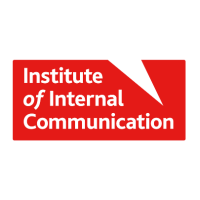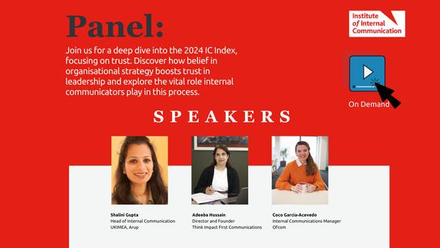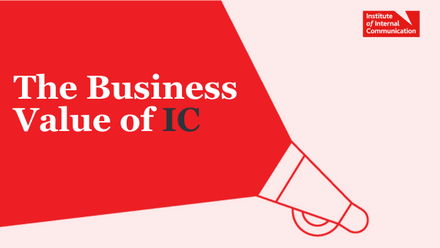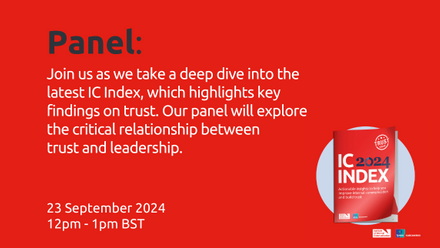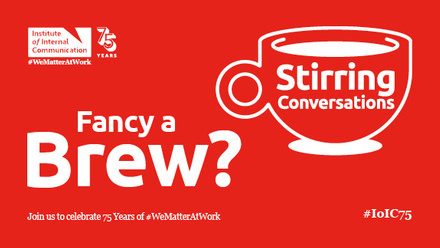Lift your impact: how to build conversational muscle

Every business I have ever worked with has a familiar list of improvement areas included in their annual employee engagement results.
- Communication: “We need more comms.”
- Involvement: “We want to make the decisions.”
- Leadership: “It has to come from the top.”
- Collaboration: “We operate in silos.”
- Innovation: “No one listens.”
Every year these arrive – like a crane delivering another baby for comms and HR teams to nurture.
So many businesses spend so much money, time and effort measuring engagement. Then seeking that special sauce to pour over their corporate culture, trying to make employees happy… Lunch time yoga. Welcome hampers. Paid charity work. They are all lovely. But they are not on the list of things that motivate a 2020s workforce or those factors that drive up engagement.
Factors that motivate the 2020s workforce:
|
Past employees |
Current employees |
|
My pay |
My purpose |
|
My satisfaction |
My development |
|
My boss |
My coach |
|
My annual review |
My ongoing conversations |
|
My weaknesses |
My strengths |
|
My job |
My life |
Ref: Gandhi, V 2018” Want to improve productivity? Hire Better Managers
As internal communicators, we are best placed to solve the engagement enigma. Helping leaders to understand the workforce, what drives them and how to connect with them is a critical part of our job. Now more than ever.
Like a hangover from last century, too much focus is put on launching annual engagement “initiatives” that fade over time. Investment in “difficult conversations for managers” is just one example of knee-jerk responses that add to the list of distractions for time-poor leaders.
Reality check: it is the everyday, routine and regular employee/leader conversations that drive results.
Not the “difficult” conversations.
Not the gimmicks.
Not your channels or content.
Not lunchtime yoga.
Our workforce has evolved
Our employees are more sophisticated and educated than ever. They are connected and global. They share information and have their say all day long on social media and in forums of interest to them. Employees are hardwired to have their say after an education of immersion and participation. They are now socialised to get involved and be part of the solution. They want to be trusted, not told what to do.
I spend my time asking internal communicators and business leaders if they have evolved to meet the needs of their employees. Have they kept up with the shifts? Are their practices and ways up to date?
Ask yourselves if your business leaders and your own ways have kept up. Have your internal communication strategies evolved? Are you sure you are aligned with the needs of your employees?
Are old school ways holding your employee communications and entire business back?
Capability counts
It is the everyday conversations and interactions between managers and employees that drive up employee performance, improve work culture and lift workforce engagement.
I work with internal communicators to help them shift their focus onto the high impact activities that support leaders to activate employee effort. Helping leaders build their impact, lift trust and get better results is where we should be investing our time.
Building capability and the conversation muscle of our leaders is going to help us move forward faster than any channel strategy or content plan ever will.
Sure, channels and content are important assets for the IC team to function and inform. But walking with leaders, lifting their capability and driving the whole of business conversation is where we can really lift the roof though employee activation. After all: isn’t this why internal communication teams exist?
Consider how your workforce has evolved
By 2030, 68% of the workforce will be born after 1980. So how we lead, unite and engage them really matters. Hierarchy, telling, delegation and one-way communication channels do not work. They erode trust, create compliance and limit thinking. Focusing our teams’ work on outdated channels, investing time on old school or traditional internal comms is limiting our results, careers and entire businesses.
We have to evolve our approach to meet the needs of the 2020s workforce: they want involvement, not information. They want purpose, not just pay. They want to be trusted, not told.
They want conversation. Not just information spat at them by corporate channels.
Different generations at work
Consider each of your generations at work. Their education, leader style or learning preferences should guide our internal communications strategy and leader communication.
|
Different Generations at work |
||||
|
|
Baby Boomers Born before 1964 |
Gen X Born 1965-79 |
Gen Y Born 1980-1994 |
Gen Z 1995-2009 |
|
Uni degrees |
– |
25% |
33% |
50% |
|
Ideal leader |
Thinker |
Doer |
Supporter |
Collaborator |
|
Leader preference |
Director |
Coordinator |
Guider |
Empowering |
|
Influenced by… |
Experts |
Practitioners |
Peers |
Forums |
|
Learning style |
Structure/Formal |
Participative |
Interactive |
Multi-modal |
Ref: www.mccrindle.com and https://www.impellam.com/articles/understanding-the-different-generations-in-the-workplace
Every business now has a significant element of remote, geographically spread or non-wired workforce. With leaders as the most prevalent and trusted channel of connection, it’s smart that we nurture them as the most valuable asset on the communication dashboard. Investing too much time elsewhere is reducing our impact. No employee app or integration is going to replace the impact or the empathy of a human interaction with their leader.
Lift leader capability: raise the roof on your results
Driving alignment of behaviour and action with strategy is our priority as communicators. But we can only achieve this when the daily manager/employee conversations are on point. This is where we can really shift the needle as communication advisers.
When internal communicators invest time lifting leaders, they lift the whole business.
Driving what I call the “big conversation” across the organisation requires us to help leaders build connection and capability. Think about it: there is no point in giving leaders the business strategy or key messages if they don’t understand employees, or can’t connect with them or host a two-way conversation.
I am sure that most of us see some leaders that aren’t listening. We may witness how their style of communication shuts down or limits employee contribution. In the same way if we fail to act on this then we are also limiting our business. It’s our role to help leaders listen and ensure employees are involved.
Supporting leaders to build deep connections, impact and trust is a must-have skill for internal communicators now.
This is vital as your employees know the issues, problems, customers and organisation much better than your leaders.
Benchmark your impact: have you kept up with the workforce?
Your employee communication acts as a roof on your business results. How we run our IC functions is either limiting or lifting outcomes.
Often a high percentage of us believe, wrongly, that we have high capability or competence.
We might think our communications are highly regarded and effective by our audience. But this can be limiting. Often, we firmly believe we are flying, when in actual fact we might be failing.
I saw this first hand recently when I worked with a large utility and embarked on a major project outsourcing many employees. The project required the leaders to be effective and high-performing communicators. So, I asked them to rate themselves.
Ninety seven percent of leaders marked themselves as good or excellent communicators. But when I asked their employees to rate their managers, they said they were absent, didn’t listen, rarely held team meetings and were unresponsive. This is known as the Dunning-Kruger effect. It is where those with lower capability often mistakenly perceive themselves as high performers or highly competent. At the same time higher capability individuals believe their level of capability to be lower than it is.
In the same way, we need to mind the gap between how effective we believe our employee communications to be, compared to what the real impact is.
Ask yourself: are your employee communications limiting or lifting results?
- Are your internal communications aligned with the needs of the 2020s workforce?
- Does your internal communication strategy build leader capability?
- Are your leaders hosting powerful conversations that activate employees and trust?
- Where does your employee communication sit on this ladder?
Growing conversation muscles: how the IC team can lift the entire business
To climb the ladder of impact, we have to help our business focus on three key aspects: degree of impact, employee response and level of trust.
When IC teams and leaders are hosting powerful conversations, we can expect greater impact, deeper activation and abundant trust.
Powerful conversations help leaders build a deeper connection with their teams, deliver on business goals and support professional growth. Powerful conversations are the how of leading; they create continual interactions between leaders and employees that consistently drive up performance and outcomes.
In line with changes in the workforce, I believe the IC fraternity needs to rethink its value add. I advocate our tribe reviews the focus as writers, doers and content creators. Shifting towards a more strategic capability building role as adviser, coach, enabler will ensure greater relevance, impact and value.
Powerful conversations for leaders: lift your entire organisation
Build conversation muscles using these four steps:
Step 1: Switch the mindset
Outcome: Help build leader appreciation that communication is a key part of their role. Help them see that with the right mindset they can become great communicators and better leaders.
Actions:
- Encourage them to try new ways to communicate, build their confidence.
- Show them how errors are a helpful part of learning, not evidence of failure.
- Use facts, data and story to show your leadership team the price, profit and productivity of employee communication.
- Encourage the IC team to “let go” of old school approaches and invest more time empowering leaders to communicate.
Step 2: Help leaders connect deeper with employees
Outcome: Leaders understand their employees better, are able to use insight to adapt their communication and leadership style. They focus more on building trust and less on telling employees what to do.
Actions:
- Use your workforce data to help managers understand employees better, eg generations, preferences, locations, style of communication and motivations.
- Help managers activate their connection super-powers. Help them understand that communication is not all about themselves of just speaking.
- Help managers give employees a voice: create opportunities to listen, experience what employees do and hear their views.
Step 3: Focus the agenda
Outcome: Leaders and IC Teams intentionally plan their conversations with employees and align these tightly with business goals.
Actions: Help leaders:
- be intentional: what is the purpose of the meeting, catch-up or conversation?
- plan the content of their conversations: this vastly increases manager results and productivity.
- translate the vision so that it specifically aligns to employee roles.
Step 4: Lead the conversation
Outcome: Leaders consistently have two-way conversations that unite and ignite.
Actions: Nurture and invest in leaders. Support them to:
- see that face-to-face communication is their stage for success
- build a rhythm of communication: make it part of how they lead, using weekly, fortnightly and monthly forums
- find their own way: help them build their own habits and rituals to lift their team
- continually grow: provide examples, tools and tips how they can improve.
Preparing for the future
When we use the powerful conversations approach we build conversation muscle in our leaders. These will strengthen the culture in our business. They lift the roof on our impact, pushing up employee effort and trust.
Embedding powerful conversations is fertile ground for internal communicators. Focusing on capability building enables us to add significantly more value than elsewhere. With the evolution of our workforce and other recent shifts at work, our insights and expertise has become more valuable. Leaders now are asking more than ever how to connect, motivate and rally the evolved, remote and often distracted workforce.
We have an opportunity right now post-pandemic to embrace and drive a change. Switching our focus in this way will certainly build better leaders. Our actions will help create a culture of conversation that activates our entire workforce. Beyond that, when we switch our focus in this way, we become more relevant, amplify our value and enhance our position as trusted experts.
Paul Matthews is a speaker, mentor and coach. He works with leaders and teams to build impact and trust using powerful conversations. Based in Australia, Paul has 25 years of global experience as a communicator, leadership adviser and executive coach. He is the author of the bestseller Switch: from telling to trusting with powerful leader conversations and co-author of What the hell do we do now? An enterprise guide to COVID19 and beyond.
